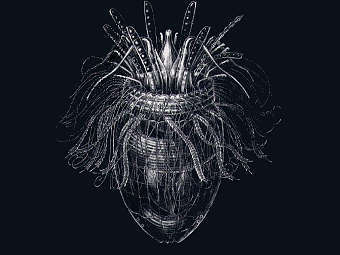www.lenta.ru/news/2010/04/07/noo2/
www.nature.com/news/2010/100406/full/464825b.ht...
 | Лорицифера Pliciloricus enigmatus. Изображение NASA |
Биологи обнаружили отказавшихся от кислорода многоклеточных
Существа размером менее одного миллиметра обитают на глубине более 3 тысяч метров. Они принадлежат к группе лорицифер - микроскопических морских беспозвоночных. Внешне они похожи на мешочки, из горла которых выходят "щупальца" (см. иллюстрацию к новости).
Ранее исследователи уже находили в местах, лишенных кислорода, многоклеточные организмы, однако у специалистов не было уверенности, обитают ли они там постоянно. Авторы новой работы полагают, что обнаруженные ими лорициферы все время живут в чрезвычайно обедненной кислородом среде.
"Обычные" многоклеточные получают энергию при помощи особых органелл, названных митохондриями, для работы которых необходим кислород. Найденные в Средиземном море лорицеферы получают энергию, используя другие органеллы - гидрогеносомы. Для функционирования гидрогеносом не нужен кислород, и они присутствуют также у живущих в отсутствие O2 микроорганизмов.
В 2009 году была опубликована работа, авторы которой заключили, что многоклеточные появились на Земле на 200 миллионов лет раньше, чем считалось до сих пор. Ученые анализировали геологические отложения возрастом свыше миллиарда лет и обнаружили в них останки организмов, напоминающих современных губок
Animals thrive without oxygen at sea bottom
Creatures found where only microbes and viruses were thought to survive.
 Some loriciferans live in anoxic sediments.R. Danovaro
Some loriciferans live in anoxic sediments.R. DanovaroLiving exclusively oxygen-free was thought to be a lifestyle open only to viruses and single-celled microorganisms. A group of Italian and Danish researchers has now found three species of multicellular animal, or metazoan, that apparently spend their entire lives in oxygen-starved waters in a basin at the bottom of the Mediterranean Sea.
The discovery "opens a whole new realm to metazoans that we thought was off limits", says Lisa Levin, a biological oceanographer at Scripps Institution of Oceanography in La Jolla, California.
Roberto Danovaro from the Polytechnic University of Marche in Ancona, Italy, and his colleagues pulled up the animals during three research cruises off the south coast of Greece. The species, which have not yet been named, belong to a phylum of tiny bottom-dwellers called Loricifera. Measuring less than 1 millimetre long, they live at a depth of more than 3,000 metres in the anoxic sediments of the Atalante basin, a place so little explored that Danovaro likens his team's sampling to "going to the Moon to collect rocks".
Researchers have previously found multicellular animals living in anoxic environments, but Danovaro says that it was never clear whether those animals were permanent residents. The new loriciferans, which he and his team reported this week (R. Danovaro et al. BMC Biol. doi:10.1186/1741-7007-8-30; 2010), seem to "reproduce and live all their life in anoxic conditions", he says.
The researchers identified an adaptation that helps these loriciferans to survive in their environment. Instead of mitochondria, which rely on oxygen, the creatures have organelles that resemble hydrogenosomes, which some single-celled organisms use to produce energy-storing molecules anaerobically.
Angelika Brandt, a deep-sea biologist at Germany's Zoological Museum in Hamburg, says that the work by Danovaro's group is "highly significant". The discovery of metazoans living without mitochondria and oxygen, she says, suggests that animals can occupy niches that once seemed too extreme.
читать дальше
